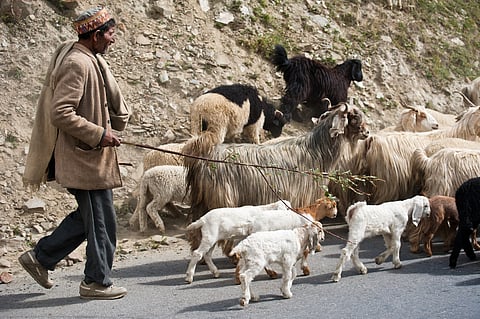

In a landmark decision, the Himachal Pradesh Forest Department has issued a notification identifying traditional pastoral routes and halting sites across the state, directing forest field officers to avoid tree planting in these areas under any afforestation scheme.
The move, announced on January 24, 2025, marks the first official recognition of pastoralist communities’ rights over grazing lands. Afforestation efforts have long disrupted pastoral movement and access to grazing areas, threatening their livelihoods. The notification aims to address these challenges by ensuring that afforestation does not encroach upon crucial migratory corridors.
A total of 1,637 locations — complete with latitude and longitude details — have been identified as key passageways or halting sites for shepherds. Forest officers have been instructed to steer clear of these areas, while a comprehensive mapping of pastoral grazing locations and migratory livestock populations has been conducted for each forest range in the state.
The mapping was done using information from Centre for Pastoralism (CfP), an organisation working on enhancing pastoralist livelihood security. CfP has been working on an atlas of Indian pastoralism, documenting its scale and spread and mapping traditional grazing routes nationwide. Himachal Pradesh was the pilot state for this initiative and its findings have informed the forest department’s decision.
“This is a result of a three-year mapping exercise. The notification recognises pastoralists as legitimate users of these lands. It will mobilise departments and civil society organisations to make TORs (terms of reference) so that division and block-level entities can start acting based on this decision,” said CfP’s Aniruddh Sheth.
Pastoralism is one of the oldest and most sustainable food systems in the world. It involves the seasonal migration of herders and livestock between different climatic zones in search of year-round fodder. These communities take advantage of suitable pastures and grasslands while avoiding extreme temperatures.
In Himachal Pradesh, communities such as the Gaddi, Gujjar, Kinnaura, Lahaula and Pangwala have practised this system for generations, adapting to seasonal variations in altitude and climate.
Mobility is key to the pastoral production system. However, decades of afforestation initiatives have restricted their mobility, impacting livelihoods. According to CfP research, approximately 100,000 families in Himachal Pradesh rely on pastoralism, yet access to traditional grazing routes has often been limited by local forest authorities—an issue prevalent across the country.
While talking to Down To Earth (DTE) in 2022, Vasant Saberwal, director for CfP, highlighted how pastoralists cover the entire state through their movement, at some point or the other.
While the forest department has officially identified 1,637 locations, Sheth had pointed out that the actual number of pastoral sites exceeds 3,000. “These 1,637 locations have been verified through ground truthing by the forest department, but our database is much larger. Many additional areas lie outside the forest department’s jurisdiction and have yet to be formally recognised,” he told DTE.
The January 24 directive also mandates the involvement of pastoral communities in tree plantation decisions..
“Tree plantation programmes can be conducted in consultation with pastoral communities, ensuring their migratory routes and halting locations are understood and mapped,” said the notification.
This approach, it said, will reduce the costs associated with “ineffective plantation efforts” by focusing on areas that are less vulnerable to grazing. The order asks the forest officers to implement a system for tracking livestock movements, managing permits and monitoring grassland health.
“This will help facilitate pastoral communities’ access to high-quality grazing areas, secure their livelihoods and protect planted areas from grazing, thereby supporting high survival tree rates,” the directive signed by Sameer Rastogi, principal chief conservator of forests in Himachal Pradesh, said.
This notification builds on a similar order issued in November 2022, which placed a moratorium on tree planting along migratory routes and halting places of pastoralists in the Chamba forest division. Chamba, home to one-third of the state’s cattle population, supports hundreds of Gaddi and Gujjar families who practise transhumance, or seasonal migration for grazing sheep, goats and buffaloes.